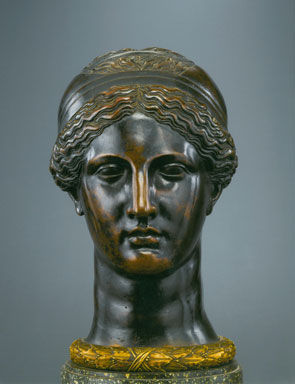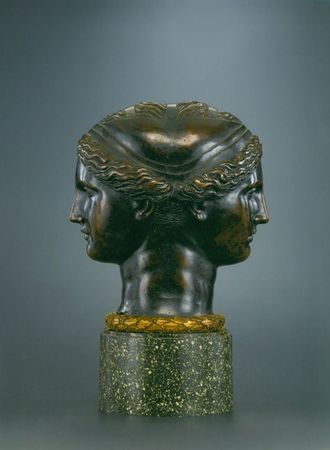28 octobre 2011
Paul Getty Museum announces acquisition of rare Francesco Primaticcio bronzePaul Getty Museum announces acquisition of rare Fran
Francesco Primaticcio, Double Head, about 1543 -1556. Bronze. Object: H: 38.5 x W: 35 x D: 20 cm L.2011.44
LOS ANGELES, CA.- The J. Paul Getty Museum has acquired a rare bronze female double head attributed to Francesco Primaticcio (Bologna, 1504–Paris, 1570). Created in France in about 1543, Double Head is closely related to the head of the so-called Cesi Juno, one of the most amous
antique marble statues in 16th-century Rome, a work that Michelangelo considered the most beautiful object in Rome.
Female double heads are unusual both in classical and post-classical sculpture. Though its original purpose is not known, Double Head most likely was conceived as an independent work of art, and is closely related to the series of bronze casts that the French king François I commissioned Primaticcio to make after the most famous antique statues in Rome. Several of those survive at the palace of Fontainebleau outside Paris.
Double Head may have been conceived as a homage to the duchesse d'Etampes, François I's mistress, who was considered "la plus savante des belles" ("the most erudite of the female beauties"), and who was said to have preferred copies of antique originals over modern works.
"This astonishingly beautiful and well preserved bronze represents a unique opportunity for the Getty to acquire a sculpture from the watershed moment in the development of the French artistic style," said David Bomford, acting director of the J. Paul Getty Museum. "Moreover, Double Head's association with a revered ancient sculpture continues the established tradition at the Getty of creating meaningful links between its ancient and modern collections, and of deepening our superlative collection of ancient and post-antique bronze sculpture."
The double-sided composition of the piece suggests it was originally intended for display on top of a herm or a column. When Henri IV had the Jardin de l'Etang (Garden of the Pond) created at Fontainebleau by 1594, Double Head was most likely placed in the oculus above the portal to the garden, where it could be admired from either side of the gate.
Antonia Boström, senior curator in the Department of Sculpture and Decorative Arts at the Getty Museum, notes that Double Head passed through some of the most important Parisian collections of the 18th and 19th centuries, including those of Pierre Crozat; his two nephews (the marquis du Chatel and the baron de Thiers); and Quentin Crauford, a Scottish collector in Paris. The sculpture's intriguing beauty made it a compelling topic for sophisticated collectors of works of antiquity, and in the 18th century it was mistaken for both an ancient and a Mannerist sculpture.
The sculpture remained in private collections through the 19th and 20th centuries. In 1976 it became part of the noted collection of Pierre Bergé and fashion designer Yves Saint Laurent, and was displayed in their Paris home.
Since the sale of their collection in 2009, the bronze has been the subject of new scholarship—historical, documentary, and technical—that has contributed to a better understanding of the work. This new research strongly suggests that Double Head belongs to a series of bronze sculptures that Primaticcio cast after the antique originals. The works were made for the French king, and some still survive at the palace of Fontainebleau.
Double Head joins three drawings by Primaticcio in the Museum's collection: Study of God the Father with Angels; Vulcan at His Forge, a preparatory study for the Galerie d'Ulysse at Fontainebleau; and Centaur Carrying Off an Amazon, which makes clear reference to the ancient world. Double Head also complements other examples of Renaissance and Baroque bronze all' antica sculpture at the Getty, such as Antico's Bust of a Young Man; Massimiliano Soldani-Benzi's Laocoön; the statuette of the Dancing Faun, formerly attributed to Giovan Battista Foggini; and Pietro Cipriani's monumental Medici Venus and Dancing Faun.
The Primaticcio acquisition is currently on view in the Italian Renaissance paintings gallery in the Museum's North Pavilion.
Francesco Primaticcio
Francesco Primaticcio (1504–1570), painter, sculptor, architect, and draughtsman to the French king, François I, played a key role in the introduction to France of an Italianate Renaissance style in painting, sculpture and architectural decoration that made reference to the formal canon and subjects of classical art. He is closely identified with the so-called First School of Fontainebleau, where he was in the king's service for almost his entire career. At Fontainebleau Primaticcio was responsible for, among many projects, the interior decoration of the Galerie d'Ulysse, the king's chamber, the bedroom of the Duchesse d'Etampes, and the designs for fêtes and costume balls for royal festivities. Under Henri II's reign (1547-59) he decorated the ballroom at Fontainebleau, built the chapel of the Hôtel de Guise, and sculpted the urn of François I's heart and two figures for his tomb. In charge of all royal buildings at the end of his career, he created a second set of decorations for the king's chamber at Fontainebleau and was responsible for the funeral monument of Henri II at the Basilica of Saint-Denis outside Paris.
antique marble statues in 16th-century Rome, a work that Michelangelo considered the most beautiful object in Rome.
Female double heads are unusual both in classical and post-classical sculpture. Though its original purpose is not known, Double Head most likely was conceived as an independent work of art, and is closely related to the series of bronze casts that the French king François I commissioned Primaticcio to make after the most famous antique statues in Rome. Several of those survive at the palace of Fontainebleau outside Paris.
Double Head may have been conceived as a homage to the duchesse d'Etampes, François I's mistress, who was considered "la plus savante des belles" ("the most erudite of the female beauties"), and who was said to have preferred copies of antique originals over modern works.
"This astonishingly beautiful and well preserved bronze represents a unique opportunity for the Getty to acquire a sculpture from the watershed moment in the development of the French artistic style," said David Bomford, acting director of the J. Paul Getty Museum. "Moreover, Double Head's association with a revered ancient sculpture continues the established tradition at the Getty of creating meaningful links between its ancient and modern collections, and of deepening our superlative collection of ancient and post-antique bronze sculpture."
The double-sided composition of the piece suggests it was originally intended for display on top of a herm or a column. When Henri IV had the Jardin de l'Etang (Garden of the Pond) created at Fontainebleau by 1594, Double Head was most likely placed in the oculus above the portal to the garden, where it could be admired from either side of the gate.
Antonia Boström, senior curator in the Department of Sculpture and Decorative Arts at the Getty Museum, notes that Double Head passed through some of the most important Parisian collections of the 18th and 19th centuries, including those of Pierre Crozat; his two nephews (the marquis du Chatel and the baron de Thiers); and Quentin Crauford, a Scottish collector in Paris. The sculpture's intriguing beauty made it a compelling topic for sophisticated collectors of works of antiquity, and in the 18th century it was mistaken for both an ancient and a Mannerist sculpture.
The sculpture remained in private collections through the 19th and 20th centuries. In 1976 it became part of the noted collection of Pierre Bergé and fashion designer Yves Saint Laurent, and was displayed in their Paris home.
Since the sale of their collection in 2009, the bronze has been the subject of new scholarship—historical, documentary, and technical—that has contributed to a better understanding of the work. This new research strongly suggests that Double Head belongs to a series of bronze sculptures that Primaticcio cast after the antique originals. The works were made for the French king, and some still survive at the palace of Fontainebleau.
Double Head joins three drawings by Primaticcio in the Museum's collection: Study of God the Father with Angels; Vulcan at His Forge, a preparatory study for the Galerie d'Ulysse at Fontainebleau; and Centaur Carrying Off an Amazon, which makes clear reference to the ancient world. Double Head also complements other examples of Renaissance and Baroque bronze all' antica sculpture at the Getty, such as Antico's Bust of a Young Man; Massimiliano Soldani-Benzi's Laocoön; the statuette of the Dancing Faun, formerly attributed to Giovan Battista Foggini; and Pietro Cipriani's monumental Medici Venus and Dancing Faun.
The Primaticcio acquisition is currently on view in the Italian Renaissance paintings gallery in the Museum's North Pavilion.
Francesco Primaticcio
Francesco Primaticcio (1504–1570), painter, sculptor, architect, and draughtsman to the French king, François I, played a key role in the introduction to France of an Italianate Renaissance style in painting, sculpture and architectural decoration that made reference to the formal canon and subjects of classical art. He is closely identified with the so-called First School of Fontainebleau, where he was in the king's service for almost his entire career. At Fontainebleau Primaticcio was responsible for, among many projects, the interior decoration of the Galerie d'Ulysse, the king's chamber, the bedroom of the Duchesse d'Etampes, and the designs for fêtes and costume balls for royal festivities. Under Henri II's reign (1547-59) he decorated the ballroom at Fontainebleau, built the chapel of the Hôtel de Guise, and sculpted the urn of François I's heart and two figures for his tomb. In charge of all royal buildings at the end of his career, he created a second set of decorations for the king's chamber at Fontainebleau and was responsible for the funeral monument of Henri II at the Basilica of Saint-Denis outside Paris.
Francesco Primaticcio (Italian, 1504 - 1570), Double Head, about 1543 -1556. Bronze. Object: H: 38.5 x W: 35 x D: 20 cm (15 3/16 x 13 3/4 x 7 7/8 in.) Object (with socle): H: 56 x W: 35 x D: 20 cm (22 1/16 x 13 3/4 x 7 7/8 in.) L.2011.44
Publicité
Publicité
Commentaires

/https%3A%2F%2Fprofilepics.canalblog.com%2Fprofilepics%2F1%2F0%2F100183.jpg)
/https%3A%2F%2Fstorage.canalblog.com%2F03%2F02%2F119589%2F96711876_o.jpg)
/https%3A%2F%2Fstorage.canalblog.com%2F11%2F31%2F119589%2F94773502_o.jpg)
/https%3A%2F%2Fstorage.canalblog.com%2F20%2F83%2F119589%2F94772815_o.jpg)
/https%3A%2F%2Fstorage.canalblog.com%2F26%2F72%2F119589%2F75604929_o.jpg)
/https%3A%2F%2Fstorage.canalblog.com%2F59%2F60%2F119589%2F26458628_o.jpg)




/http%3A%2F%2Fstorage.canalblog.com%2F05%2F88%2F119589%2F110900108_o.jpg)
/http%3A%2F%2Fstorage.canalblog.com%2F57%2F04%2F119589%2F32502995_o.jpg)
/http%3A%2F%2Fstorage.canalblog.com%2F91%2F49%2F119589%2F76368760_o.jpg)
/http%3A%2F%2Fstorage.canalblog.com%2F79%2F85%2F119589%2F74383196_o.jpg)